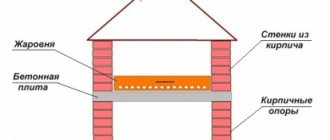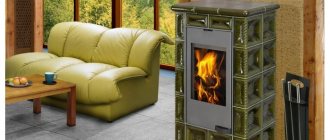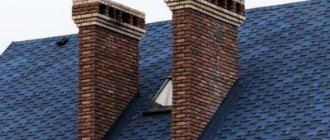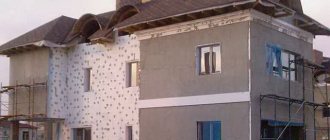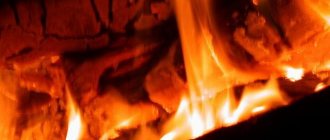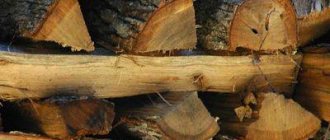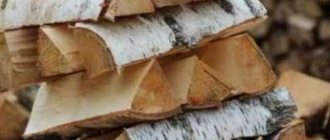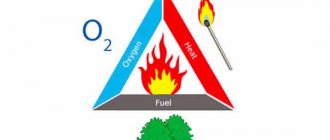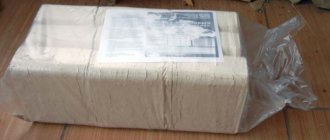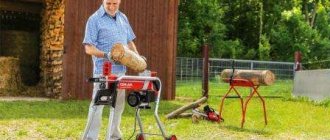Why build a chimney?
Many lazy people do not see the point in arranging a chimney for barbecue in a summer gazebo . They count on the wind to blow the smoke out from under the canopy, but in reality this does not happen. As soon as you start frying the meat, the entire gazebo is covered with clouds of smoke, and if there is a hood, it is removed outside.
If this is not done, then after using the barbecue, a layer of soot and soot will settle on the ceiling, which is extremely difficult to clean off. If you frequently fry meat on a grill like this, the kebab will be seasoned with soot falling off on top.
In addition, a hearth with an open flame that is not equipped with an exhaust hood poses a fire hazard.
Hood calculation
Thermal power of the fryer.
It is generally accepted that 1 kg of shish kebab requires 0.75-1 kg of coal. For 1 person you need 400-700 grams of meat. The specific heat of combustion of charcoal is 7.5 kW.
And we get for 6 guests we need a grill with thermal power: minimum 0.4*6*0.75*7.5 = 13.5 kW maximum 0.7*6*1*7.5 = 31 kW.
Usually, a large amount of meat is fried on the grill in several batches. For further calculations, we will use a “round number” of power of 15 kW.
Fryer area.
D=2*A*B/(A+B)
Where: A – width of the brazier, m; B – length of the brazier, m.
D = 2*0.4*0.6/(0.4+0.6) = 0.48 m
Share of convective heat releases.
Qk=QT*KЯ*KK
Where: QT – thermal power of the barbecue or hearth, kW; KYa is the fraction of sensible heat released from the fryer, the value is taken to be 250 W/kW; KK – fractional part of convective heat releases in relation to sensible heat releases of the fryer, the value is taken to be 0.5.
Qk = 15*250*0.5 = 1875 W
Convective air flow.
Lki=k*Qk1/3*(z+1.7*D)5/3*r
Where: k – coefficient equal to 5·10-3; Qk is the calculated fraction of convective heat release from the fryer, W. z – distance from the grill to the exhaust hood, m, cannot be less than 0.75 m; D – fryer area; r – correction factor for placement conditions: between 3 walls - 0.75, against a wall - 0.8, free or island - 1.1;
Let's calculate for a hood with access to the barbecue from all sides and a minimum height from the barbecue to the hood hood.
Lki = 5·10-3*18751/3*(0.75+1.7*0.48)5/3*1.1 = 0.224 m3
Volumetric gas flow rate for combustion products.
Lri=1.51·10-7*QT
Lri = 1.51·10-7*15 = 2.26·10-6 m3
Gas consumption in the hood.
Lo=Lki+Lri
Where: Lki is the value of air flow from the convective flow rising above the slab, m3/s; Lri – data on the volumetric flow rate of natural gas combustion products in the stove burners, m3/s.
Lo = 224·10-3 + 2.26·10-6 = 0.224 m3/s
Consumption per hour.
(D)/L=Lo*3600*D
(D)/L = 0.224*3600*0.48 = 421.63 m3/h
Types of smoke exhaust structures
The types of smoke exhaust structures and materials for their manufacture do not differ in variety.
In gazebos of any type, chimneys for barbecues are made of metal or brick. Brick structures are mainly used in stationary barbecues made from the same material. They look very attractive, but cleaning them properly is quite difficult, and sometimes simply impossible. To build a brick chimney, you must have the skills of a mason; in addition, the cost of such a structure is much higher than that of a metal product. Therefore, prudent owners most often prefer to build a metal hood over the barbecue.
Metal
Chimneys made of metal have the following advantages :
- availability of DIY assembly;
- ease of installation;
- low weight;
- smoothness of the inner surface;
- ease of cleaning;
- the ability to give the product any shape.
Almost any home craftsman with skills in working with power tools and welding equipment can assemble a metal chimney.
If you do not have a welding machine, you can secure the structural elements with bolts. The metal hood does not create a serious load on the base of the gazebo; its walls have a smooth surface, on which, unlike brickwork, soot contaminants do not stick. If it is necessary to use it seasonally or move it to another place, the structure can be easily disassembled. It can be painted any color with heat-resistant paint.
Brick
Brick chimneys have their advantages . With high-quality layout, a capital structure will delight its owners with its appearance and serve them for a long time. A hood made of brick has the following advantages:
- long service life;
- low degree of heating;
- attractive appearance;
- the ability to equip a brazier in the hood.
The grill bowl and chimney must be built using only fireproof mixture and bricks .
Otherwise, the highly heated structure will be destroyed.
A few words about folding barbecues
The folding barbecue is a lightweight brazier that can be easily moved and installed in the right place, including in the gazebo. The best material for its manufacture is considered to be stainless steel, the optimal wall thickness is two millimeters.
Thinner sheets will quickly burn out, thick ones will significantly increase the weight of the structure. To improve the combustion process, through holes are made around the perimeter of the lower part of the fryer. Through them, coals can fall onto the floor of the gazebo and ignite it. In addition, the folding grill easily tips over, so you need to use it very carefully.
Advantages
However, a folding grill has certain advantages. These include:
- light weight for easy transportation;
- when disassembled, the grill easily fits into the trunk of a car;
- low cost.
The big advantage of a folding barbecue is the ability to use it without installing a hood.
A small roasting pan does not produce a lot of smoke when cooking meat . As a rule, a folding barbecue is installed in gazebos, which are a canopy without walls. In closed gazebos it must be equipped with a hood.
What is a barbecue fan?
According to fire safety standards, a spark arrestor must be provided for forced draft in the barbecue. It can be dry or wet type. The dry spark arrestor is made in the form of a mesh. It is inexpensive, but quickly becomes clogged with fat and is not able to reduce the smoke temperature. More complex wet spark arrestors are hydraulic filters.
The cost of such a device is significantly higher, and the dimensions are larger. However, the hydrofilter greatly reduces the temperature of the smoke and extinguishes sparks.
Since the fan operates in an environment of hot smoke and high humidity with impurities of fat, it has some requirements:
- The motor protection level must be at least IP44.
- Only metal impellers are allowed.
- All parts of the device must be able to withstand high temperatures.
It is also worth paying attention to the noise level created by a running engine.
Gas grill
This type of grill has a very simple design. A gas burner is located in the center of the metal box, and a grate is installed on top of it. In order for the meat to roast well, the height of the walls of the box should not exceed ten centimeters, and their thickness should be at least two centimeters. The advantages of this design of the fryer are its instant heating, the ability to control the temperature regime, and the absence of soot contamination during use. Meat cooked on a gas grill will be well-done and tasty. It will not smell like smoke, but it will also contain fewer harmful elements.
How to make a chimney yourself?
to make a chimney for a barbecue on your own .
It is easier and simpler to make a metal structure than a brick one, but each job has its own nuances.
Making a metal smoke extractor
The best materials for making a metal smoke eliminator are sheets of copper and stainless steel.
Their cost is quite high, so many owners prefer to use ordinary metal. This is quite acceptable, but the thickness of the sheets must be at least two millimeters. Otherwise, the structure made from them will soon burn through or suffer from the development of a corrosion process . To prevent this, the material is treated with an anti-corrosion compound and coated with a varnish that is resistant to high temperatures. It is not recommended to use standard galvanized sheets - they are too thin and the zinc coating quickly burns.
Brick structures
properly set up a barbecue with a brick chimney yourself , since it is one of the simplest structures built from this material. A ten-centimeter concrete foundation is poured under it.
A waterproofing layer of two layers of roofing material is laid on top.
Then a base is laid out on which the roasting pan will rest. Its outer part is lined with brick, and a box welded from metal sheets is inserted inside. The easiest way to make a chimney is in the same way - a dome made of metal is lined with brick on the outside. A damper is made in its lower part, and a protective umbrella is installed on top to prevent precipitation from penetrating inside.
Advantages of an exhaust hood
Installing an exhaust hood over a barbecue has the following advantages:
- the ability to control the combustion process;
- leveling the effects of wind;
- protection against the formation of soot and soot;
- completed appearance of the structure.
We recommend watching an interesting video on this topic.
Calculation features
This procedure can be carried out in two ways. For the first one you need to calculate:
- Temperature of gases at the entrance to the pipe.
- The average speed of smoke passing through the chimney.
- Firewood combustion rate.
- The volume of air required to support combustion.
These values need to be inserted into the formula and calculated how much gas will exit through the chimney. Next, the resulting figure is inserted into another formula and the optimal cross section of the chimney . It is assumed that the height of the chimney will be 5 m . Since this method requires the calculation of many indicators and is quite complex, it is used very rarely.
There is a simpler method. It will appeal to anyone who wants to make a classic grill with a pipe . This method is also called Swedish. According to it, you need to calculate only two indicators and use a special chart.
Indicators:
- Firebox area.
- The area of the chimney duct.
To use the graph, you need to divide the area of the chimney duct by the area of the firebox . This relationship is displayed on the abcis axis. The y-axis indicates the height of the chimney.
The graph has three lines. Each of them denotes a chimney with a different cross-section : round, square and rectangular. The figure that was calculated above is looked for on the abscissa axis and then pointed upward with a finger. Next, the finger must cross one of the three lines. At the intersection point, look at the ordinate axis and determine the height of the chimney. If the result is a very large height, for example, 3.5 m, then you need to re-calculate, taking a larger channel area.
According to this method, the following chimney is suitable for a metal barbecue with dimensions of 72x25 cm:
- The height of the chimney is 2 m.
- The diameter of a pipe or channel with a round cross-section is 16-17 cm.
Using this method, you can also calculate the parameters of the chimney of a barbecue, which you plan to build from brick. The method was first created for fireplaces. They are very similar to a brick barbecue or grill.
Since the method takes into account very few factors, the resulting result has errors.
Features of construction and operation
When building a chimney, certain features must be taken into account for its proper functioning. To create good traction, its upper cut should rise above the ridge of the roof. If the hood has a square cross-section, the side size should be 25 centimeters. A round chimney must have at least fifteen centimeters in diameter.
These are the most optimal sizes for the formation of high-quality draft in the smoke removal system.
In conclusion, we can say that installing a barbecue hood in a gazebo significantly increases the comfort and safety of cooking over an open flame. It is quite possible to make a chimney yourself; there is nothing particularly difficult about it. A properly manufactured structure has a long service life.
Difficulty in operation
When making a hood with your own hands, an inexperienced builder faces certain problems that are easier to prevent in the initial stages of construction:
- The smoke does not rise to sufficient height and disturbs those present. To prevent the smoke emanating from the brazier from floating nearby in the air, the upper part of the pipe should be positioned at a height of at least 3 meters above the ground. This will ensure good draft and removal of combustion products to the required height.
- When the fryer is ignited, the smoke disperses throughout the room and does not escape into the hood. In this case, draft does not occur due to the same density of smoke and surrounding air. Initially, the smoke has a low temperature. Once the fire is sufficiently hot, the temperature and density of the smoke will increase and sufficient draft will be generated.
- The problem remains even after the fire has started. This is a reliable sign that the cross-section of the chimney has been incorrectly calculated. For the hood to work effectively, the square cross-section of the chimney must exceed 0.26 by 0.26 meters, and the vertical pipe, thanks to aerodynamic processes, can have a diameter of 0.15 by 0.20 meters.
The barbecue should be built, strictly observing the order of laying the bricks. In this case, the structure will have a maximum service life and aesthetic appearance. If there is an arch in the design plan, then a key brick should be placed in the center of it, evenly distributing the load over the entire arched structure. For construction, refractory fireclay bricks of type M-250, similar to those used in the metallurgical industry, should be used.
